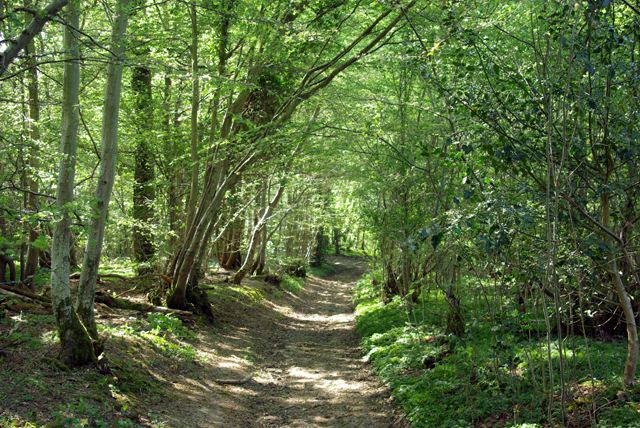
Path in Marline Wood, Sussex, credit Wikipedia
ENDNOTES, December 2021
In this edition: Elgar, Ireland and Holst from the English Music Festival; Fairy Tales for saxophone and piano; reviewed by Stuart Millson
The Autumn English Music Festival, held at St. Mary’s Church, Horsham, was memorable for four performances in particular: a moving, deeply-studied account of Elgar’s Violin Sonata of 1918; Ireland’s Violin Sonata in D minor (1908-9); songs for tenor and piano by Gustav Holst; and a too-rarely-heard rendition of Madeleine Dring’s almost cabaret-like John Betjeman settings. On the afternoon of Saturday 13th November, violinist Rupert Marshall-Luck took to the platform at St. Mary’s, accompanied by pianist, Nathan Williamson, with a programme of music that included Vaughan Williams’s The Lark Ascending, the Legende by Frederick Delius and the charming “salon” pieces by Elgar, Salut d’Amour, Chanson de Nuit and Chanson de Matin – all played with depth, charm and beauty – but all exceeded by the complete immersion of the artists in Elgar’s sublime Violin Sonata, a product of the composer’s stay, late in the First World War, in secluded woodland in Sussex.
It was Lady Elgar who remarked that in the forest surroundings, a “wood magic” had begun to take hold of her husband’s writing. For so long associated with rich choral and orchestral works, here, deep in the Sussex countryside, Elgar’s vision found equal boundless energy and emotion through the medium of chamber music; the surging splendour of his symphonies dovetailed into the music of just violin and piano, and yet sacrificing nothing in this world of smaller forms. Rupert Marshall-Luck responded to and projected all the boldness and impetuousness of the opening bars, uncovering along the way – like woodland shadows – the softer introspection of Elgar’s sighs and threads of melody. Nathan Williamson made the sonata more than just an exercise in accompaniment: somehow, the work seemed in the hands of these fine artists almost like a concerto in miniature.
There have been many interpretations of this piece, but Rupert Marshall-Luck brings to the work – especially in the mysterious majesty of the last movement – a more effective, thoughtful, slower pace than practically any other performer. Thankfully, the English Music Festival’s recording arm, the innovative EM Records, has produced a studio performance of Mr. Marshall-Luck’s version of Elgar’s Violin Sonata – a CD that confirms the violinist as the foremost exponent of the work. One can only hope that he turns his attention one day to Elgar’s masterful Violin Concerto.
And if this powerful Elgar section of the programme was not enough, the Marshall-Luck-Williamson partnership delivered a brilliant account of Ireland’s Violin Sonata of 1909; a work that begins in an ardent spirit, but which soon subsides into the loneliness and reflection which we expect of Ireland – that unique, detached figure in our musical life who seemed to see visions of the past in the ancient Sussex and Dorset landscape. Again and again in the first movement, a phrase of touching lyrical beauty is heard – a somewhat sad and nostalgic theme, echoed by the piano; and again, given such memorable treatment by Nathan Williamson.
John Ireland also featured in the evening song recital, given by tenor James Gilchrist – with Nathan Williamson accompanying – our pianist showing no signs of exhaustion from his long afternoon with Elgar, Vaughan Williams and Delius. Quite the reverse, with Mr. Gilchrist ushering in a renewed world of beauty and springtime in Ireland’s Land of Lost Content, the first warm breath of the year, encapsulated in The Lent Lily. The calming music of Ivor Gurney followed; Gurney, a composer and poet was shell-shocked in the Great War. But his gentle, heartfelt setting of Down by the Salley Gardens (1920) seems far away from any battlefield. Frank Bridge’s FourSongs (1925) – the composer at his most astringent – brought an atmosphere of coldness and dissonance to the evening, but Holst’s A Vigil of Pentecost, and Humbert Wolfe Songs brought listeners into an ethereal, supernatural state; especially in the ‘Vigil’s’ pre-echo of the Venus movement from The Planets, and in the unearthly, distant landscape of Betelgeuse. Finally, James Gilchrist rounded things off with Madeleine Dring’s Betjeman settings: a reflective “teatime tide” at a Bay in Anglesey (one could almost hear the poet himself reading it, with the cry of gulls in the background); and an outrageous moment of cabaret, as our singer stepped into a bohemian Soho setting in the Song of a Nightclub Proprietess. Full marks to Mr. Gilchrist for this theatrical touch!
Finally, some Russian and Baltic fairy tales courtesy of Norwood Recordings and their artists, Kyle Horch (alto and soprano saxophone) and pianist, Yshani Perinpanayagam. The CD is superbly recorded – the saxophone sounding remarkably seductive, embracing the listener with its not-quite-classical sound, a sound more reminiscent, perhaps, of jazz. Yet as the album unfolds, such thoughts are put to one side: the saxophone telling wonderful stories, especially in the Lithuanian Eduardas Balsys’s Little Fish (the best tune on the disc – a folksy dance-like three minutes); Eduard Tubin’s more demonstrative, abstract Sonata for Piano and Saxophone; and the Cinq Melodies, Op. 35 by Prokofiev. An unusual disc, but one that is ideal for a winter’s evening – perhaps accompanied by a glass of something warming, and a frosty view from your living-room window.
Stuart Millson is the Classical Music Editor of The Quarterly Review
Elgar, Violin Sonata, performed by Rupert Marshall-Luck, violin, and Matthew Rickard, piano, on EM Records, CD 011.
Fairy Tales, Kyle Horch, saxophone, Norwood Records, NR 202101.










